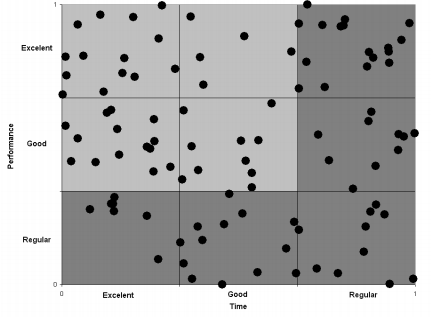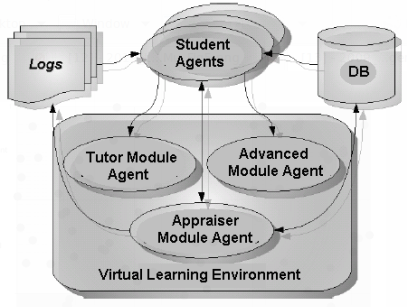2009 ABeliefDesireIntentionMultiAgen
- (Mateus et al., 2009) ⇒ Gustavo Pereira Mateus, Beatriz Wilges, Luiz Claudio Duarte Dalmolin, Silvia Nassar, and Ricardo Silveira. (2009). “A Belief Desire Intention Multi Agent System in a Virtual Learning Environment.” In: Proceedings of the 2009 Ninth IEEE International Conference on Advanced Learning Technologies. ISBN:978-0-7695-3711-5 doi:10.1109/ICALT.2009.213
Subject Headings: Belief-Desire-Intention (BDI) Agent System, Multi-Agent System, Virtual Learning Environment.
Notes
Cited By
Quotes
Author Keywords
Abstract
This research proposes the use of a Belief Desire Intention (BDI) agent architecture that can be integrated with Virtual Learning Environments (VLE). Thus we are developing and implementing a methodology that considers the main agents in this architecture. The BDI architecture applied in this study was based on Jadex. In addition this platform is standalone and goal oriented thus facilitating the implementation of the proposal. The results of the message exchange between agents and the goals to adapt the interface of the AVA according to the identified profile are presented in this article.
I. INTRODUCTION
An Artificial Intelligence technique, such as Multi-Agent System (MAS) architecture, might be a way to diversify the different learning and teaching strategies that are applied in Virtual Learning Environments (VLE). This research aims to meet the educational and technological infrastructure needs of the chosen environment, but the objectives of this work are focused on the idea that any environment can use the same proposal. The central point and of great interest to various researches has been the possibility of building VLEs, based on MAS, to ensure learning suppofi and adaptation to the students characteristics.
The success of a student’s learning in a Virtual learning environment depends a lot on his individual motivation. As a general rule, more motivated participants capable to learn online are those who are self disciplined, organized and those that are able to manage their time well. For these, even a poorer application, in terms of interactivity and design, does not constitute an obstacle to their learning. Our challenge will be to find ways to keep high motivation levels during the whole teaching/learning process, even to those students that do not stick to the desirable profile for distance teaching.
With this purpose we intend to work with different groups of students. The intention is to accomplish a tracking of the student from his/her logs during the learning process in the environment and capture results of the students through the VLE’s evaluation system. This evaluation system was implemented to work with specific content questions.
Many user characteristics are stored in the VLE’s server. These characteristics correspond to the session time on the web pages, the performance of the students in the questionnaire, the time taken to answer the questionnaire among other information. The goal of this work is to use this information in a way that it is possible to improve the VLE’s interface. Thus the MAS approach has been used. Besides that it is considered that some students have a better performance in the evaluation system than others. Thus, in this research, it was considered the mapping of these different characteristics. This was done to extract the various states that might lead to an adaptation of the interface. The mapping in Fig. 1 shows the possible states which were considered.
According to Fig. 1 states are regular, good and excellent for the two variables considered: time and performance. The points in the light region represent the students with acceptable performanee/time and the points in the dark region represent students with more difficulties. This way, the environment will act in a different way since it is guided by the profile of the identified student.
One possibility to create a model of adaptation to MAS based VLE involves general characteristics that are implemented in most learning environments. These characteristics involve the log and evaluation of the students performance through tasks such as questionnaires. With these attributes it is possible to create a community of agents that work these characteristics to be able to identify the profile of the student. Furthermore, communication between agents may, at any time, adapt the strategy in accordance with the educational profile identified.
II. THE VIRTUAL TEACHING ENVIRONMENT USED IN THIS RESEARCH
The Virtual teaching environment used as study of ease in this research is called SestatNet [2]. It is a versatile on line Statistics teaching/learning environment. It offers and applies description procedures, hypothesis tests and regression models for qualitative and quantitative variables. SEstatNet is available at http://sestat.net.
In this distance course the student plans and puts into practice a research on terms of getting the data that will serve as the significant object and learning motivator. The teaching/learning process has as base active methodologies of learning. This way, it enables the students to learn the statistics conceptions, applying them to their own data in each session. The individual movement of learning is free, in a way that the contents do not have a pre-settled sequence of presentation.
III. DEVELOPING OF THE BDI AGENT ARCHITECTURE IN THE VLE
With the use of the environment, the distribution of time and its parameters will be determined for each learning profile. In these cases, it is possible to estimate distinct groups on learning process. Thus, there is a group that works very quickly, another one that is inside the hoped time and also those that delay excessively to take a decision. The aim is to follow the student, and give him some feedbacks through his interaction with the environment. A BDI agent communication interface was developed in this research to conduct the student during the teaching learning process.
The developed architecture is based on general characteristics from the VLE, thus it was necessary to define and to specify the different agents involved in this architecture. The goal of the BDI agents is to make interface adaptations through analysis of the VLE data base. This data base contains information about the student interaction in the environment, like interaction time, questionnaire answers, student access frequency, among others.
The BDI JadeX platform was used to develop the MAS implementation presented in this research. JadeX is a Java based, FIPA compliant agent environment, and allows to develop goal oriented agents following the BDI model [1]. In JadeX, agents have beliefs, which can be any kind of Java object and are stored in a belief base. Goals are implicit or explicit descriptions of states to be achieved. To achieve its goals the agent executes plans, which are procedural recipes coded in Java [3]. The agents of the BDI MAS architecture and their goals, beliefs and plans are presented by the Fig. 2.
The designed architecture uses 4 (four) kinds of agents, named student, appraiser, tutor and advanced. For each student that uses the environment there is one instance of the “student agent”. The “appraiser”, “tutor” and “advanced” agents are the available resources to be used by the students in the environment. Initially the students interact in the environment through the mentoring and evaluation modules. This modules record the student’s interaction in log files. Besides the answered and saved questions in the database the agents, who represent the students, update their beliefs databases with information regarding the performance of students, from the log files. In order to indicate the most appropriate module to the student, the student agent processes the information obtained through action plans, and stats the message exchange with the tutor module agent or the advanced module agent. Thus the student is led to use the module that best suits his/her level of learning.
IV. CONCLUSIONS
The learning process is formed by teaching situations where the individuals have constant and positive reinforcement for correct answers. Wrong answers must be avoided in order to prevent wrong behaviors. Teaching situations are presented in small learning units and increasing degree of complexity. At the end of each unit there are always questions and feedback (seen as a reward for the correct answers and as suppofis in case of errors).
Multi-agent systems represent a promising direction in the computer—assisted education area. In some VLEs it is necessary that agents have the capability of reasoning. Thus the BDI architecture proposal, which models agents with beliefs, desires and intentions, makes the implementation of agents in a VLE possible. The BDI agents allow the management of resources in a VLE, making interface adaptation of the environment. The student agent senses the user by the recognition of his profile while student is using the environment. Then, the student agent selects, among the available resources, the most suited resource to be activated and stats the message exchange to the agent that represents this resource. This process happens dynamically at every user action in the environment.
References
;
| Author | volume | Date Value | title | type | journal | titleUrl | doi | note | year | |
|---|---|---|---|---|---|---|---|---|---|---|
| 2009 ABeliefDesireIntentionMultiAgen | Gustavo Pereira Mateus Beatriz Wilges Luiz Claudio Duarte Dalmolin Silvia Nassar Ricardo Silveira | A Belief Desire Intention Multi Agent System in a Virtual Learning Environment | 10.1109/ICALT.2009.213 | 2009 |

